Reedsport: Finding Data on Coastal Douglas
September 11, 2023Douglas County is a big place. At 5,000 square miles, it contains more land area than nine U.S. states. So it’s natural that some trends can be overlooked by only using data on the whole county.
In this short article I’ll share the most recent demographic and economic data we have on one particular community: Reedsport. Reedsport and the surrounding area has some similarities to the rest of Douglas County and Oregon, but many unique local features as well.
Population and Demographics
The city of Reedsport is a small community of about 4,000 in western Douglas County. Because of its physical distance from the population centers of the Willamette and Umpqua Valleys, it looks economically distinct and has many ties with the coastal communities of Lane, Coos, and Curry counties.
Throughout this article, I’ll make references to Reedsport (typically meaning city limits), Reedsport’s Urban Growth Boundary (or UGB), and the broader surrounding area of coastal Douglas County (find a map of this geography and more data using this link from Census Reporter). That’s because different data is available depending on the geography, and also because different trends or questions emerge by looking at the city or the broader area.
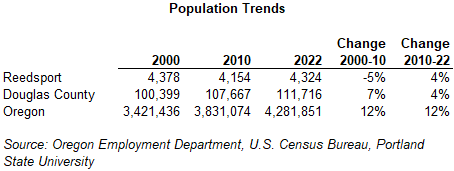
Like Douglas County, Reedsport has grown in population more slowly than the state, adding 4% in total between 2010 and 2022, compared with the state’s 12% growth. However, unlike Douglas and most areas of Oregon, it lost population during the 2000s, declining 5% between 2000 and 2010 while Douglas County grew by 7% and the state added 12%.

Coastal Douglas residents have a lower median household income than the county, state, and nation. Residents are significantly less likely to participate in the labor force than the U.S., at 45% labor force participation compared with 63% statewide and 64% in the U.S. Low labor force participation is partly a product of the older population – the median age is 53 versus 38 for the nation – as well as differing levels of education. Higher levels of education are correlated with higher workforce participation rates.
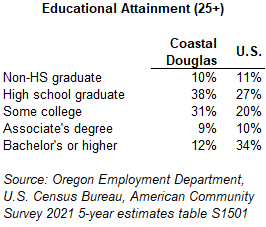
Speaking of education, the local population is slightly more likely to have a high school diploma, but significantly less likely than the U.S. population to have a bachelor’s degree or higher. About 12% of the coastal Douglas population has a bachelor’s degree or higher, compared with 34% of the U.S. population.
Economy and Workforce
Employers within Reedsport’s Urban Growth Boundary employed an average of 1,510 workers in 2021 across 236 establishments. The average wage per worker was about 25% lower than the county, which undoubtedly contributes to the lower household income.

Why are wages lower in Reedsport? To some extent, it’s for the same reasons wages are lower in Douglas County, but even more so. Certain industries with lower average wages such as retail and accommodation and food services make up a bigger portion of jobs in Reedsport and Douglas; some high-wage industries such as financial activities and wholesale trade aren’t as prevalent. Other high-wage industries are as much of the industry mix, but pay less on average locally, such as professional services, which typically command a higher wage premium in larger cities.
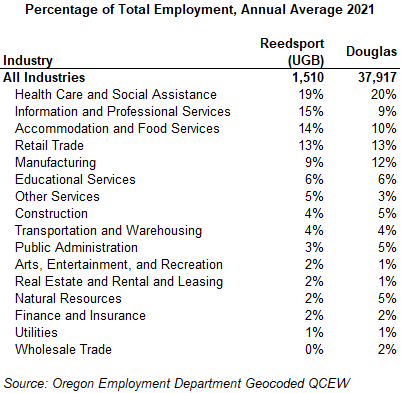
Health care and social assistance is an interesting exception, which paid about the same as the state average, and made up a higher percentage of jobs in Douglas and Reedsport, which underlies the sector’s importance for coastal and rural communities. Manufacturing, construction, and natural resources are key industries less prevalent in Reedsport than in the county overall.
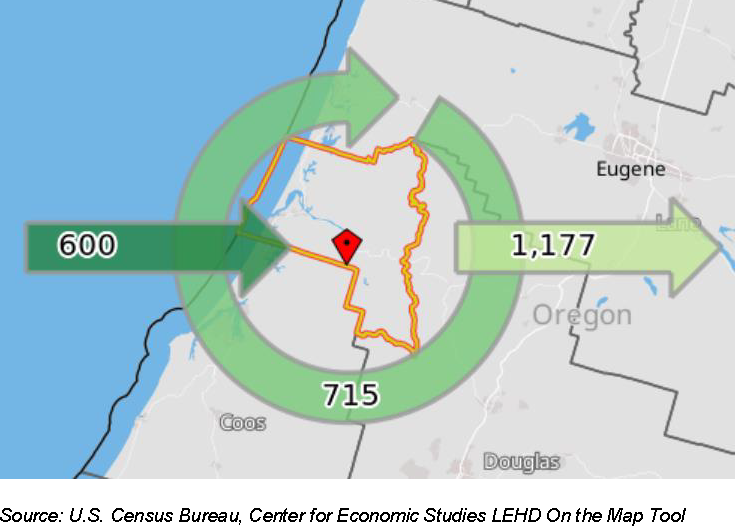
Given the wage differential and prevalent industries, many local workers commute out of the area for work. Of the 1,900 workers living in the area, about 1,200 (62%) commute out for their job. The top five destinations after the city of Reedsport were Coos Bay, Florence, Eugene, Roseburg, and North Bend, with 3% to 9% of workers working in each of these locations.
In addition, 600 workers commute in to the area from outside, with a slightly smaller geographic distribution. These do not necessarily represent daily commutes, but they do have something to do with the economic ties of workers in the area.
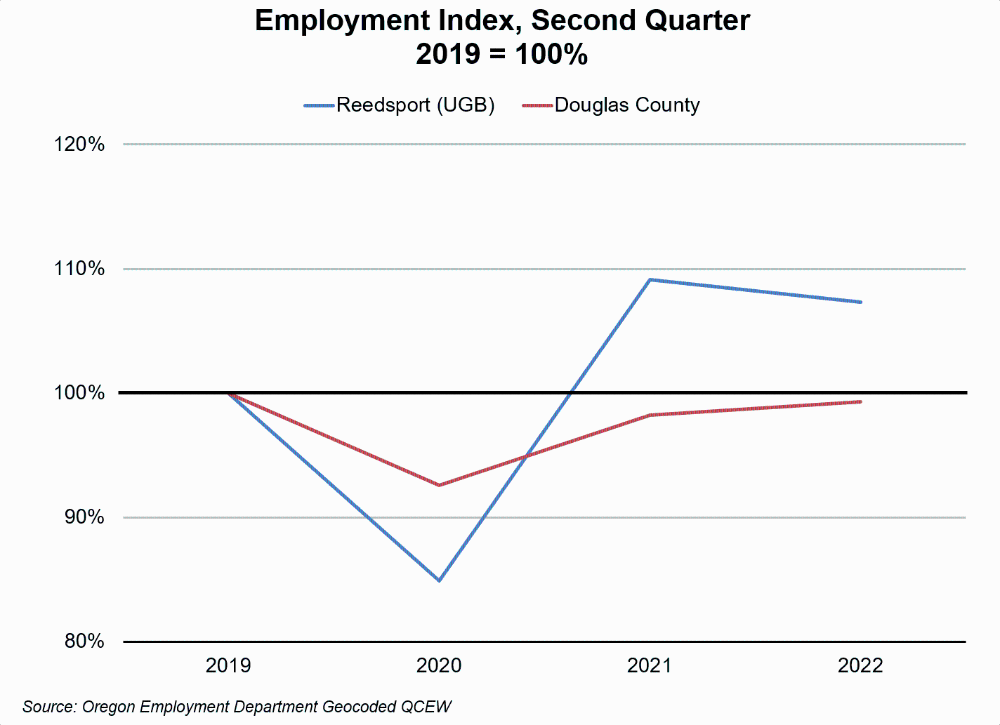
Reedsport UGB has an interesting economic trajectory through the disruption of the last recession. Looking at employment in the second quarter of each of the last four years, Reedsport suffered deeper job losses in 2020 than the county, but then sprang back more quickly. In terms of total jobs, Reedsport had more employment in 2022 than before the recession, even with a slight decline from 2021 to 2022.
At the same time, Douglas County overall hasn’t recovered to pre-2020 levels. As of the most recent data (July 2023), Douglas County remains about 2% down in jobs relative to February 2020 on a seasonally adjusted basis.
New data about economies, employment, and population comes out all the time, so in addition to resources like the Census Reporter and QualityInfo.org, your local workforce analyst can provide data or show you how to access it for the communities you’re interested in knowing more about. Please reach out at the contact us page if there are ways we can assist.